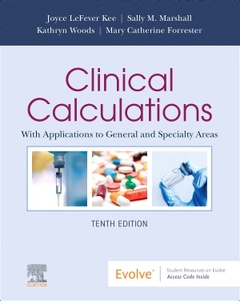Description
Clinical Calculations (10th Ed.)
With Applications to General and Specialty Areas
Authors: Kee Joyce LeFever, Marshall Sally M., Forrester Mary Catherine, Woods Kathryn
Language: English
Subjects for Clinical Calculations:
100.48 €
In Print (Delivery period: 14 days).
Add to cart464 p. · 21.5x27.6 cm · Paperback
Description
/li>Contents
/li>
Learn the most common methods of drug calculation, and use the one that is right for you! Clinical Calculations: With Applications to General and Specialty Areas, 10th Edition helps you learn to calculate drug dosages accurately. It covers the four major drug calculation methods - basic formula, ratio and proportion, fractional equation, and dimensional analysis - plus body weight and body surface area. It also includes practice problems not only for general care but also for specialty areas such as pediatrics and critical care. Written by a team of experts, this market-leading text shows how drug calculation and drug administration are related and emphasizes patient safety above all else.
- Coverage of four major drug calculation methods includes basic formula, ratio and proportion, fractional equation, and dimensional analysis, plus body weight and body surface area, enabling you to learn and apply the method that works best for you.
- Information on drugs, drug administration techniques, and devices helps you master the most up-to-date techniques of drug administration, including oral, intravenous, intra-muscular, subcutaneous, and other routes.
- Calculations for Specialty Areas section addresses the drug calculations needed to practice in pediatric, labor and delivery, critical care, and community settings.
- Detailed, full-color photos and illustrations show current equipment for IV therapy, the latest types of pumps, and the newest syringes.
- Practice problems are included for specialty units - pediatrics, critical care, pediatric critical care, labor and delivery, and community - in addition to general patient areas.
- Comprehensive post-test allows you to test your knowledge of key concepts from the text.
- Information on pumps covers insulin and enteral infusion pumps, plus intravenous infusion pumps such as single and multi-channel, PCA, ands syringe, explaining their use in drug administration.
- Caution boxes provide alerts to problems or issues related to various drugs and their administration.
- NEW! Next-Generation NCLEX® examination-style and NGN Prep questions introduce the new elements from the updated NCLEX exam, assessing critical thinking, clinical judgment, and decision-making based on actual clinical situations.
Clinical Calculations: With Applications to General and Specialty Areas, 10e
Part I: Basic Math Review
Part II: Systems, Conversion, and Methods of Drug Calculation
Chapter 1: Systems Used for Drug Administration
Chapter 2: Conversion Within the Metric, Apothecary, and Household Systems
Chapter 3: Interpretation of Drug Labels, Drug Orders, Bar Codes, MAR and eMAR,
Automation of Medication Dispensing, and Abbreviations
Chapter 4: Prevention of Medication Errors
Chapter 5: Alternative Methods for Drug Administration
Chapter 6: Methods of Calculation
Chapter 7: Methods of Calculation for Individualized Drug Dosing
Part III: Calculations of Oral, Injectable, and Intravenous Drugs
Chapter 8: Oral and Enteral Preparations with Clinical Applications
Chapter 9: Injectable Preparations with Clinical Applications
NEW! Chapter 10: Insulin Administration
Chapter 11: Intravenous Preparations with Clinical Applications
Part IV: Calculations for Specialty Areas
Chapter 12: Pediatrics
Chapter 13: Critical Care
Chapter 14: Pediatric Critical Care
Chapter 15: Labor and Delivery
Chapter 16: Community
Part V: Post-Test: Oral Preparations, Injectables, Intravenous, and Pediatrics
Appendix A: Guidelines for Administration
Appendix B: Nomograms: Child and Adult
References
Index
These books may interest you

Calculate with Confidence 109.28 €



